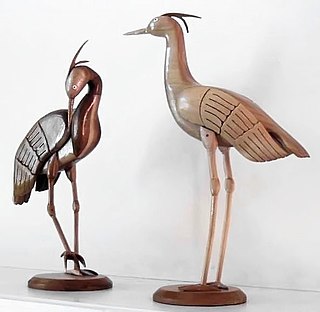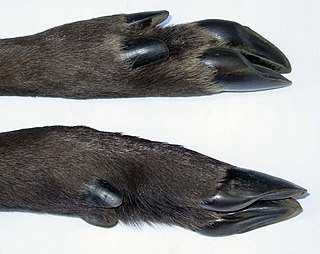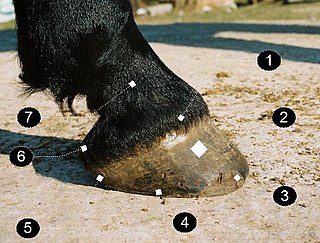Related Research Articles

Adhesive, also known as glue, cement, mucilage, or paste, is any non-metallic substance applied to one or both surfaces of two separate items that binds them together and resists their separation.

A horseshoe is a fabricated product, normally made of metal, although sometimes made partially or wholly of modern synthetic materials, designed to protect a horse hoof from wear. Shoes are attached on the palmar surface of the hooves, usually nailed through the insensitive hoof wall that is anatomically akin to the human toenail, although much larger and thicker. However, there are also cases where shoes are glued.

Woodworking is the skill of making items from wood, and includes cabinet making, wood carving, joinery, carpentry, and woodturning.

Shellac is a resin secreted by the female lac bug on trees in the forests of India and Thailand. It is processed and sold as dry flakes and dissolved in alcohol to make liquid shellac, which is used as a brush-on colorant, food glaze and wood finish. Shellac functions as a tough natural primer, sanding sealant, tannin-blocker, odour-blocker, stain, and high-gloss varnish. Shellac was once used in electrical applications as it possesses good insulation qualities and it seals out moisture. Phonograph and 78 rpm gramophone records were made of it until they were replaced by vinyl long-playing records from 1948 onwards.

Plywood is a material manufactured from thin layers or "plies" of wood veneer that are glued together with adjacent layers having their wood grain rotated up to 90 degrees to one another. It is an engineered wood from the family of manufactured boards which include medium-density fibreboard (MDF), oriented strand board (OSB) and particle board (chipboard).

Joinery is a part of woodworking that involves joining pieces of wood, engineered lumber, or synthetic substitutes, to produce more complex items. Some woodworking joints employ mechanical fasteners, bindings, or adhesives, while others use only wood elements.

A hoof, plural hooves or hoofs, is the tip of a toe of an ungulate mammal, strengthened by a thick and horny keratin covering.

Neatsfoot oil is a yellow oil rendered and purified from the shin bones and feet of cattle. "Neat" in the oil's name comes from an Old English word for cattle. Neatsfoot oil is used as a conditioning, softening and preservative agent for leather. In the 18th century, it was also used medicinally as a topical application for dry scaly skin conditions.

Laminitis is a disease that affects the feet of ungulates and is found mostly in horses and cattle. Clinical signs include foot tenderness progressing to inability to walk, increased digital pulses, and increased temperature in the hooves. Severe cases with outwardly visible clinical signs are known by the colloquial term founder, and progression of the disease will lead to perforation of the coffin bone through the sole of the hoof or being unable to stand up, requiring euthanasia.

Animal glue is an adhesive that is created by prolonged boiling of animal connective tissue in a process called rendering. In addition to being used as an adhesive it is used for coating and sizing, in decorative composition ornaments, and as a clarifying agent.

Rabbit-skin glue is a sizing that also acts as an adhesive. It is essentially refined rabbit collagen, and was originally used as an ingredient in traditional gesso.

A countertop, also counter top, counter, benchtop, worktop or kitchen bench, Bunker (Scottish) is a raised, firm, flat, and horizontal surface. They are built for work in kitchens or other food preparation areas, bathrooms or lavatories, and workrooms in general. The surface is frequently installed upon and supported by cabinets, positioned at an ergonomic height for the user and the particular task for which it is designed. A countertop may be constructed of various materials with different attributes of functionality, durability and aesthetics, and may have built-in appliances, or accessory items relative to the intended application.
Wood glue is an adhesive used to tightly bond pieces of wood together. Many substances have been used as glues.

Kopytka are a kind of potato dumpling in Polish, Belarusian, and Lithuanian cuisines. They are similar to Italian gnocchi.
Kluski is a generic Polish name for all kinds of soft, mushy dumplings, usually without a filling. At times the word also refers to noodles and pasta as well, especially when they are served in soup.

A horse hoof is the lower extremity of each leg of a horse, the part that makes contact with the ground and carries the weight of the animal. It is both hard and flexible. It is a complex structure surrounding the distal phalanx of the 3rd digit of each of the four limbs, which is covered by soft tissue and keratinised (cornified) matter.

A hoof boot is a device made primarily of polyurethane and is designed to cover the hooves of a horse as an alternative to, and occasionally in addition to, horseshoes. Hoof boots can also be used as a protective device when the animal has a hoof injury that requires protection of the sole of the hoof, or to aid in the application of medication. There are many different designs, but all have the goal of protecting the hoof wall and sole of the horse's hoof from hard surfaces, rocks and other difficult terrain.

Edge banding or edgebanding is the name of both a process and an associated narrow strip of material used to create durable and aesthetically pleasing trim edges during finish carpentry.

The limbs of the horse are structures made of dozens of bones, joints, muscles, tendons, and ligaments that support the weight of the equine body. They include two apparatuses: the suspensory apparatus, which carries much of the weight, prevents overextension of the joint and absorbs shock, and the stay apparatus, which locks major joints in the limbs, allowing horses to remain standing while relaxed or asleep. The limbs play a major part in the movement of the horse, with the legs performing the functions of absorbing impact, bearing weight, and providing thrust. In general, the majority of the weight is borne by the front legs, while the rear legs provide propulsion. The hooves are also important structures, providing support, traction and shock absorption, and containing structures that provide blood flow through the lower leg. As the horse developed as a cursorial animal, with a primary defense mechanism of running over hard ground, its legs evolved to the long, sturdy, light-weight, one-toed form seen today.